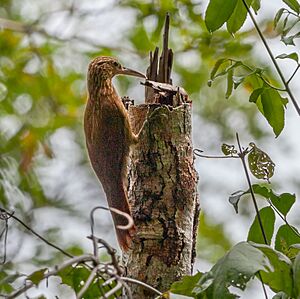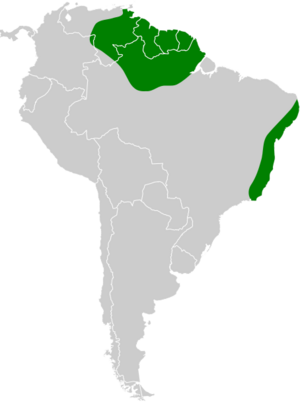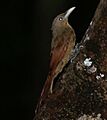Buff-throated woodcreeper facts for kids
Quick facts for kids Buff-throated woodcreeper |
|
|---|---|
 |
|
| In Rio Grande do Norte | |
| Conservation status | |
| Scientific classification | |
| Genus: |
Xiphorhynchus
|
| Species: |
guttatus
|
| Subspecies | |
|
See text |
|
 |
|
| Range of the "buff-throated" group of X. guttatus (see the Taxonomy and Distribution sections) | |
| Synonyms | |
|
Dendrocolaptes guttatus |
|
The buff-throated woodcreeper (Xiphorhynchus guttatus) is a type of bird found in many South American countries. These include Bolivia, Brazil, Colombia, Ecuador, French Guiana, Guyana, Peru, Suriname, and Venezuela. It belongs to the ovenbird family called Furnariidae.
Contents
About Its Family
For a long time, the cocoa woodcreeper was thought to be the same species as the buff-throated woodcreeper. But since the 1990s, scientists have decided they are different species. These two birds are very closely related and form a "superspecies," meaning they are like close cousins.
The way scientists group the buff-throated woodcreeper is still being discussed. Most groups, like the American Ornithological Society, say there are eight different types, called subspecies. These subspecies are divided into three main groups:
- "Buff-throated" group
- X. g. polystictus
- X. g. connectens
- X. g. guttatus
- "Lafresnaye's" group
- X. g. guttatoides
- X. g. dorbignyanus
- "Dusky-billed" group (also called the "eytoni" group)
- X. g. eytoni
- X. g. vicinalis
- X. g. gracilirostris
Some bird experts think that the "Lafresnaye's" and "dusky-billed" groups should be their own separate species, called "Lafresnaye's woodcreeper." This would mean the buff-throated woodcreeper would only include the first three subspecies. More studies are needed to figure out the exact family tree of these birds.
If the main buff-throated woodcreeper (X. g. guttatus) becomes its own species, it might be considered endangered. This is because its home is shrinking.
For now, this article will follow the idea that there are eight subspecies.
What It Looks Like
The buff-throated woodcreeper is a medium-sized bird, about 22.5 to 29.5 cm (9 to 11.5 in) long. It weighs between 45 and 74 g (1.6 to 2.6 oz). It's the biggest bird in its group, with a strong body and a long, curved beak. Both male and female birds look alike.
Adults of the main subspecies (X. g. guttatus) have a dark brown face with thin, light streaks. Their head and neck are dark brown with buff-colored spots. Their back and wing feathers are reddish olive-brown, with light streaks. Their lower back and tail are a reddish-brown color. Their throat is a deep buff color. Their chest and belly are reddish-brown, with streaky patterns. Their eyes are dark brown, and their beak is dark brownish-black with a lighter tip. Their legs and feet can be blue, greenish-gray, or dark gray. Young birds have a shorter, blacker beak and more reddish bellies.
Other subspecies have slight differences in color and beak shape:
- X. g. polystictus: Has a darker head than its back, with wide, dark streaks on its back.
- X. g. connectens: Similar to polystictus but with deeper buff colors and heavier streaks.
- X. g. guttatoides: Has a pale beak and is more reddish overall. Its head is darker than its back.
- X. g. dorbignyanus: Has a paler beak than guttatoides and is lighter and more olive.
- X. g. eytoni: Has a slimmer, mostly black beak, more olive upper parts, and a grayer belly.
- X. g. vicinalis: Has a blackish beak, whitish throat, and very reddish underparts.
- X. g. gracilirostris: Similar to eytoni but with a longer, slimmer, and more curved beak.
Where It Lives
The buff-throated woodcreeper lives in different parts of South America:
- X. g. polystictus: Found near the Orinoco River in eastern Colombia, Venezuela, and northern Brazil. It also lives in the Guyanas.
- X. g. connectens: Lives north of the Amazon River, from Manaus east to Amapá in Brazil.
- X. g. guttatus: Found along the coast of eastern Brazil, from Rio Grande do Norte south to Espírito Santo.
- X. g. guttatoides: Lives in the western Amazon Basin, including southern Venezuela, eastern Ecuador, Peru, and northwestern Brazil.
- X. g. dorbignyanus: Found in the southern Amazon Basin, from northern Bolivia east into Brazil.
- X. g. eytoni: Lives in Brazil south of the Amazon, from Rio Tapajós east to Maranhão.
- X. g. vicinalis: Found in Brazil south of the Amazon, from Rio Madeira east to Rio Tapajós.
- X. g. gracilirostris: Lives in the Serra do Baturité in northeastern Brazil.
This bird usually lives in humid evergreen forests. However, it can be found in many different types of tree-filled areas. These include forests that lose some leaves, forests along rivers, palm swamps, and even tree-filled savannas. Some live in areas that flood seasonally. They like the edges of forests, open spots, and older secondary forests, but they also live deep inside untouched forests. Most buff-throated woodcreepers live from sea level up to about 800 meters (2,600 feet) high. Some can be found even higher, up to 1,250 meters (4,100 feet) in certain mountain areas.
How It Behaves
Movement
Scientists believe that all types of buff-throated woodcreepers stay in the same area all year round. They do not migrate.
Feeding
The buff-throated woodcreeper mainly eats arthropods, which are creatures like insects and spiders. Sometimes, it also eats small animals with backbones. It usually hunts alone or sometimes in pairs. They have been seen in groups of three near army ant swarms.
This bird often joins groups of different bird species that hunt together. It usually looks for food in the middle and upper parts of the forest trees. It moves up and along tree trunks and branches, picking and pecking for food. It finds prey on leaves, in dead leaf clusters, among plants growing on trees, in dead wood, and in termite nests. Sometimes, it even peels off bark to find food. When following army ants, it will fly from a branch to pick up food from the ground or catch insects in the air.
Breeding
The time of year when the buff-throated woodcreeper breeds changes depending on where it lives. Birds in the northern areas tend to breed in the first half of the year. Those further south breed later. This species builds its nests in holes in dead trees. These holes can be natural or made by woodpeckers. They usually lay two eggs, but sometimes one or three. We don't know how long the eggs take to hatch or how long it takes for the young birds to leave the nest. We also don't know many details about how the parents care for their young.
What It Sounds Like
All types of buff-throated woodcreepers are quite noisy. During their breeding season, they sing for long periods at dawn and dusk, and sometimes throughout the day. However, their songs are different depending on the subspecies.
The main subspecies sings "te-e-e-e-e-e-e-e-e, quirt-quirt-quirt-quirt." Other subspecies have different songs:
- X. g. polystictus and X. g. connectens sing a "loud...descending whinny of 20–25 notes."
- Birds in western Amazonia sing "a series 3–4 seconds long of melancholy whistles that ascends, levels, then descends and decreases in both volume and speed."
- Those in southeastern Amazonia sing "a long, rapid trill that descends, then trails off."
Their calls are quite similar among all subspecies. They include "a descending series of 3–6 loud whistles" and a "piercing whistle."
Its Status
The IUCN (International Union for Conservation of Nature) considers the buff-throated woodcreeper to be of "Least Concern." This means it's not currently in danger of disappearing. Both the "buff-throated" group and the "Lafresnaye's" group (which some scientists consider a separate species) are listed as Least Concern.
These birds live in very large areas. While their exact numbers aren't known, their populations are thought to be decreasing. No immediate major threats have been found for most of them. However, the main subspecies (X. g. guttatus) lives in scattered parts of the Atlantic Forest. It is likely to be sensitive to the continued loss of its forest home. The other subspecies are fairly common and are probably not too affected by changes in their environment.
Images for kids



